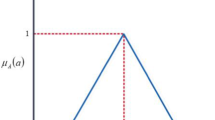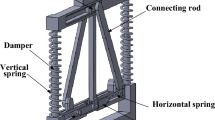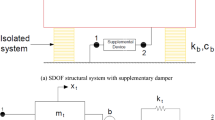Abstract
The objective of this study is to develop, simulate and verify experimentally a model of a nonlinear spring, based on the principle of a cantilevered beam with a mass on its tip, and whose overall lateral vibration is constrained by a specially shaped rigid boundary. The focus here is the use of this spring for vibration reduction applications. The modeling approach uses concepts of plane kinematics of rigid bodies, combined with quasi-static analysis to develop suitable equations of motion for a base-excited spring with a ninth-order geometric nonlinearity. In addition, a parametric identification procedure is implemented for obtaining the required coefficients for computational simulations. An approximated analytical solution to the model is completed with the aid of the method of harmonic balance and its stability is assessed through Floquet theory. Finally, the model is experimentally verified, with the use of two specimens, fabricated specifically for this study. The model, simulations and experimental measurements show the hardening and broadband behavior of the nonlinear spring.













Similar content being viewed by others
References
Blackwell, R.J.: Christiaan Huygens’ The Pendulum Clock, or, Geometrical Demonstrations Concerning the Motion of Pendula as Applied to Clocks, 1st edn. Iowa State University Press, Ames (1986)
Borowski, V.J., Denman, H.H., Cronin, D.L., Shaw, S.W., Hanisko, J.P., Brooks, L.T., Mikulec, D.A., Crum, W.B., Anderson, M.P.: Reducing vibration of reciprocating engines with crankshaft pendulum vibration absorbers. SAE Trans. 100(2), 376–382 (1991). https://doi.org/10.4271/911876
Caruntu, D.I.: Dynamic modal characteristics of transverse vibrations of cantilevers of parabolic thickness. Mech. Res. Commun. 36(3), 391–404 (2009). https://doi.org/10.1016/j.mechrescom.2008.07.005
Haddow, A.G., Shaw, S.W.: Centrifugal pendulum vibration absorbers: an experimental and theoretical investigation. Nonlinear Dyn. 34(3/4), 293–307 (2003). https://doi.org/10.1023/B:NODY.0000013509.51299.c0
Keer, L., Silva, M.: Bending of a cantilever brought gradually into contact with a cylindrical supporting surface. Int. J. Mech. Sci. 12(9), 751–760 (1970). https://doi.org/10.1016/0020-7403(70)90050-0
Kluger, J.M., Sapsis, T.P., Slocum, A.H.: Robust energy harvesting from walking vibrations by means of nonlinear cantilever beams. J. Sound Vib. 341(April 14), 174–194 (2015). https://doi.org/10.1016/J.JSV.2014.11.035
Kluger, J.M., Slocum, A.H., Hardt, D.E., Kluger, J.M.: Nonlinear beam-based vibration energy harvesters and load cells. Ph.D. thesis, MIT (2014)
Krack, M., Gross, J.: Harmonic Balance for Nonlinear Vibration Problems. Springer Nature Switzerland, Cham (2019). https://doi.org/10.1007/978-3-030-14023-6
Liu, W., Liu, C., Li, X., Zhu, Q., Hu, G.: Comparative study about the cantilever generators with different curve fixtures. J. Intell. Mater. Syst. Struct. 29(9), 1884–1899 (2018). https://doi.org/10.1177/1045389X17754274
Lu, Z., Wang, Z., Zhou, Y., Lu, X.: Nonlinear dissipative devices in structural vibration control: a review. J. Sound Vib. 423(June 9), 18–49 (2018). https://doi.org/10.1016/j.jsv.2018.02.052
Mcfarland, D.M., Bergman, L.A., Vakakis, A.F.: Experimental study of non-linear energy pumping occurring at a single fast frequency. Int. J. Non-Linear Mech. 40(6), 891–899 (2005). https://doi.org/10.1016/j.ijnonlinmec.2004.11.001
Nayfeh, A.H., Balachandran, B.: Applied Nonlinear Dynamics, 2nd edn. Wiley-VCH, Weinheim (2004)
Rivlin, B.: Micromecanical flexures: non-linear springs for enhancing the functionality of electrostatic transducers. Ph.D. thesis, TECHNION (2012)
Rivlin, B., Elata, D.: Design of nonlinear springs for attaining a linear response in gap-closing electrostatic actuators. Int. J. Solids Struct. 49(26), 3816–3822 (2012). https://doi.org/10.1016/j.ijsolstr.2012.08.014
Sharif-Bakhtiar, M., Shaw, S.: The dynamic response of a centrifugal pendulum vibration absorber with motion-limiting stops. J. Sound Vib. 126(2), 221–235 (1988). https://doi.org/10.1016/0022-460X(88)90237-4
Shaw, S.W.: The dynamics of a harmonically excited system having rigid amplitude constraints, Part 1: subharmonic motions and local bifurcations. J. Appl. Mech. 52(2), 453–458 (1985). https://doi.org/10.1115/1.3169068
Shaw, S.W.: The dynamics of a harmonically excited system having rigid amplitude constraints, Part 2: chaotic motions and global bifurcations. J. Appl. Mech. 52(2), 459–464 (1985). https://doi.org/10.1115/1.3169069
Shaw, S.W., Wiggins, S.: Chaotic motions of a torsional vibration absorber. J. Appl. Mech. 55(4), 952–958 (1988). https://doi.org/10.1115/1.3173747
Shmulevich, S., Joffe, A., Grinberg, I.H., Elata, D.: On the notion of a mechanical battery. J. Microelectromech. Syst. 24(4), 1085–1091 (2015). https://doi.org/10.1109/JMEMS.2014.2382638
Shmulevich, S., Rivlin, B., Hotzen, I., Elata, D.: A gap-closing electrostatic actuator with a linear extended range. J. Microelectromech. Syst. 22(5), 582–585 (2013). https://doi.org/10.1109/Transducers.2013.6626833
Silva, C.E., Maghareh, A., Tao, H., Dyke, S.J., Gibert, J.: Evaluation of energy and power flow in a nonlinear energy sink attached to a linear primary oscillator. J. Vib. Acoust. 141(6), 061012 (2019). https://doi.org/10.1115/1.4044450
Spreemann, D., Folkmer, B., Manoli, Y.: Realization of nonlinear springs with predefined chracteristic for vibration transducer based on beam structures. In: Mikro System Tecknik Kongress, pp. 371–374. Darmstadt, Deutschland (2011)
The Mathworks Inc.: MATLAB (2018)
Timoshenko, S.: Strength of Materials Part II, 2nd edn. D. Van Nostrand Company Inc., New York (1940)
Vakakis, A.F., Gendelman, O., Bergman, L.A., McFarland, D.M., Kerschen, G., Lee, Y.S.: Nonlinear Targeted Energy Transfer in Mechanical and Structural Systems. Springer, Berlin (2008)
Wang, C., Zhang, Q., Wang, W., Feng, J.: A low-frequency, wideband quad-stable energy harvester using combined nonlinearity and frequency up-conversion by cantilever-surface contact. Mech. Syst. Signal Process. 112(11), 305–318 (2018). https://doi.org/10.1016/j.ymssp.2018.04.027
Wang, J., Wierschem, N., Spencer, B.F., Lu, X.: Experimental study of track nonlinear energy sinks for dynamic response reduction. Eng. Struct. 94(July 1), 9–15 (2015). https://doi.org/10.1016/J.ENGSTRUCT.2015.03.007
Wang, J., Wierschem, N.E., Spencer, B.F., Lu, X.: Track nonlinear energy sink for rapid response reduction in building structures. J. Eng. Mech. 141(1), 04014104 (2015). https://doi.org/10.1061/(ASCE)EM.1943-7889.0000824
Wierschem, N.E.: Targeted energy transfer using nonlinear energy sinks for the attenuation of transient loads on building structures. Ph.D. thesis, University of Illinois at Urbana-Champaign (2014)
Wierschem, N.E., Hubbard, S.A., Luo, J., Fahnestock, L.A., Spencer, B.F., McFarland, D.M., Quinn, D.D., Vakakis, A.F., Bergman, L.A.: Response attenuation in a large-scale structure subjected to blast excitation utilizing a system of essentially nonlinear vibration absorbers. J. Sound Vib. 389(February 17), 52–72 (2017). https://doi.org/10.1016/J.JSV.2016.11.003
Yuan, Z., Liu, W., Zhang, S., Zhu, Q., Hu, G.: Bandwidth broadening through stiffness merging using the nonlinear cantilever generator. Mech. Syst. Signal Process. 132, 1–17 (2019). https://doi.org/10.1016/j.ymssp.2019.06.014
Acknowledgements
The authors would like to express their appreciation to the National Secretariat of Science, Technology, and Innovation, of the Government of Ecuador, and The Graduate School at Purdue University, for their financial support.
Author information
Authors and Affiliations
Corresponding author
Ethics declarations
Conflict of interest
The authors declare that they have no conflict of interest.
Additional information
Publisher's Note
Springer Nature remains neutral with regard to jurisdictional claims in published maps and institutional affiliations.
Appendix
Appendix
The selection of a ninth-order polynomial of the form \(P(u) = a_1 u+a_9 u^9\) as the form of the nonlinear characteristic of the device was made based on analyzing several possible fit options to the theoretical deformation of the beam for a set force, using a discretization of 600 points for the fit.
-
1.
The classic cubic shape, very common in other types of NES, did not fit the special property of the beam NES to have a quasi-asymptotic stiffness toward the edge of the boundary. Figure 14 shows a cubic fit case. The goodness of fit corresponding to this case was found to be \(R^2 = 0.952\), for a root mean-squared error of \(\mathrm {RMSE} = 5.31\%\)
-
2.
A high-order full polynomial was also tested as an option, including more terms to capture as most of the behavior as possible. In this case, a better fit was obtained, but at the cost of having a wavy behavior (see Fig. 15) that would produce unwanted dynamics in the model. The goodness of fit for this case was increased to an \(R^2 = 0.9982\), and an \(\mathrm {RMSE} = 1.23\%\).
-
3.
The final option analyzed was a pure ninth-order function with a linear component. This case offered a reasonably well fit curve, without compromising the smoothness or continuity. The goodness-of-fit parameters were found to be fairly close to those on the full polynomial, \(R^2 = 0.9916\), and an \(\mathrm {RMSE} = 2.65\%\). This fit is shown in Fig. 16. Additionally, this option resulted in a simplified derivation of the harmonic balance method for obtaining the approximate exact solution of the EOM of the system, thus providing a balance between computational efficiency and result accuracy.
Rights and permissions
About this article
Cite this article
Silva, C.E., Gibert, J.M., Maghareh, A. et al. Dynamic study of a bounded cantilevered nonlinear spring for vibration reduction applications: a comparative study. Nonlinear Dyn 101, 893–909 (2020). https://doi.org/10.1007/s11071-020-05852-8
Received:
Accepted:
Published:
Issue Date:
DOI: https://doi.org/10.1007/s11071-020-05852-8







